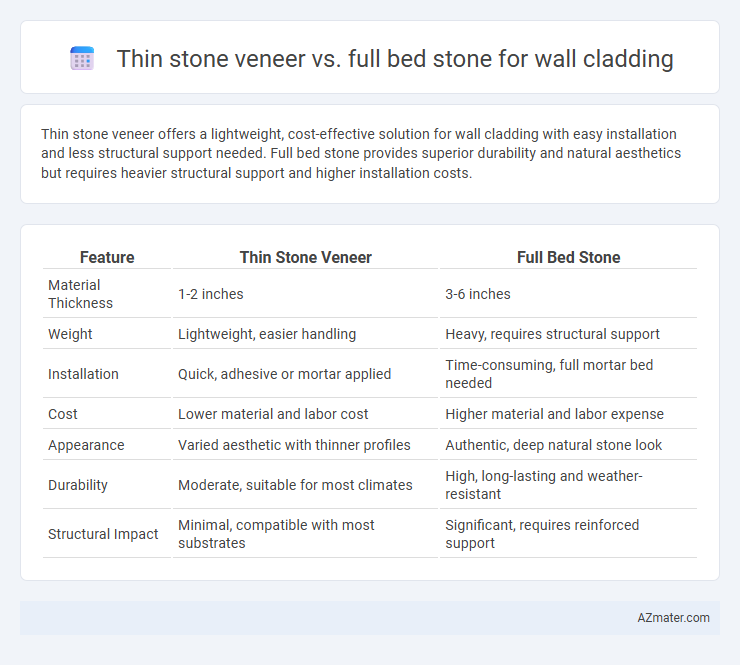Thin stone veneer offers a lightweight, cost-effective solution for wall cladding with easy installation and less structural support needed. Full bed stone provides superior durability and natural aesthetics but requires heavier structural support and higher installation costs.
Table of Comparison
| Feature | Thin Stone Veneer | Full Bed Stone |
|---|---|---|
| Material Thickness | 1-2 inches | 3-6 inches |
| Weight | Lightweight, easier handling | Heavy, requires structural support |
| Installation | Quick, adhesive or mortar applied | Time-consuming, full mortar bed needed |
| Cost | Lower material and labor cost | Higher material and labor expense |
| Appearance | Varied aesthetic with thinner profiles | Authentic, deep natural stone look |
| Durability | Moderate, suitable for most climates | High, long-lasting and weather-resistant |
| Structural Impact | Minimal, compatible with most substrates | Significant, requires reinforced support |
Introduction to Stone Wall Cladding
Stone wall cladding enhances architectural aesthetics by providing a durable and natural finish to building exteriors and interiors. Thin stone veneer offers lightweight, versatile installation with a thinner profile ideal for retrofit projects, while full bed stone involves thicker, heavier slabs for robust structural integrity and a traditional look. Selecting between thin stone veneer and full bed stone depends on factors such as wall load capacity, budget, and desired visual effect.
What is Thin Stone Veneer?
Thin stone veneer is a lightweight, thin layer of natural or manufactured stone typically ranging from 0.5 to 2 inches thick, designed for use as a decorative wall cladding. Unlike full bed stone, which consists of thick, load-bearing stones often several inches thick, thin stone veneer is easier to install and requires less structural support. It provides the aesthetic appeal of natural stone with reduced material costs and installation time, making it ideal for both interior and exterior applications.
Understanding Full Bed Stone Cladding
Full bed stone cladding involves using thick, natural stone slabs typically ranging from 1 1/2 to 3 inches in thickness, providing robust structural support and superior durability for exterior walls. This method requires skilled masons and a mortar bed for installation, ensuring each stone is securely embedded and contributing to the wall's overall strength and weather resistance. Full bed stone cladding offers excellent thermal mass, enhanced sound insulation, and a timeless aesthetic that makes it ideal for high-end architectural projects demanding longevity and a natural stone appearance.
Installation Process: Thin Veneer vs Full Bed
Thin stone veneer installation involves adhering lightweight stone slices directly onto prepared surfaces using mortar or construction adhesive, allowing for easier handling and faster application. Full bed stone cladding requires setting larger, thicker stones with a full mortar bed, demanding skilled labor and longer curing time for proper structural bonding. The thin veneer method reduces overall wall weight and installation time, whereas full bed installation offers enhanced durability and load-bearing capacity.
Weight and Structural Considerations
Thin stone veneer typically weighs between 8 to 15 pounds per square foot, significantly lighter than full bed stone, which can weigh 20 to 30 pounds per square foot. This reduced weight makes thin stone veneer more suitable for installations on walls with limited structural support, minimizing the need for additional reinforcement. Full bed stone requires a robust substructure due to its substantial weight and thickness, often necessitating reinforced framing or masonry walls to safely bear the load.
Cost Comparison: Material and Installation
Thin stone veneer offers a cost-effective alternative to full bed stone for wall cladding, with material prices typically 30-50% lower due to reduced stone thickness and weight. Installation costs for thin veneer are also generally lower, as it requires less structural support and can be applied directly to existing substrates, decreasing labor time by up to 40%. Conversely, full bed stone involves higher expenses in both materials and skilled labor because of its substantial weight, need for mortar setting, and more complex foundation requirements.
Design Flexibility and Aesthetics
Thin stone veneer offers superior design flexibility with lightweight panels that can be easily cut and installed on various wall surfaces, enabling intricate patterns and modern aesthetics. Full bed stone provides a more traditional and robust appearance with thicker, natural stone slabs that enhance texture and depth but require more structural support. Both options deliver distinct visual appeals; thin veneer suits contemporary designs with sleek finishes, while full bed stone fosters a classic, rustic charm in architectural cladding.
Durability and Maintenance Needs
Thin stone veneer offers easier installation and lower weight, but generally has lower durability compared to full bed stone, which provides superior strength and long-lasting performance due to its solid, thicker composition. Maintenance requirements for thin veneer include periodic sealing and inspections to prevent water intrusion and adhesive failure, while full bed stone demands less frequent upkeep, benefiting from its inherent sturdiness and resistance to environmental wear. Choosing full bed stone cladding ensures enhanced durability with minimal maintenance, ideal for high-impact or exposed wall surfaces.
Environmental Impact and Sustainability
Thin stone veneer offers a smaller environmental footprint due to reduced material extraction, lower transportation emissions, and less waste generation compared to full bed stone cladding. The lighter weight of thin stone veneer decreases the energy required for installation and structural support, enhancing overall sustainability. Full bed stone, while durable, involves significant quarrying and heavy transport, increasing its environmental impact and resource consumption.
Choosing the Right Stone Cladding for Your Project
Thin stone veneer offers lightweight, cost-effective installation with versatile design options, making it ideal for interior walls and non-load-bearing applications. Full bed stone provides superior durability and authentic natural stone appearance, recommended for exterior walls and structural cladding requiring long-term strength. Selecting the right stone cladding depends on project budget, structural requirements, aesthetic preferences, and environmental exposure.

Infographic: Thin stone veneer vs Full bed stone for Wall cladding
 azmater.com
azmater.com